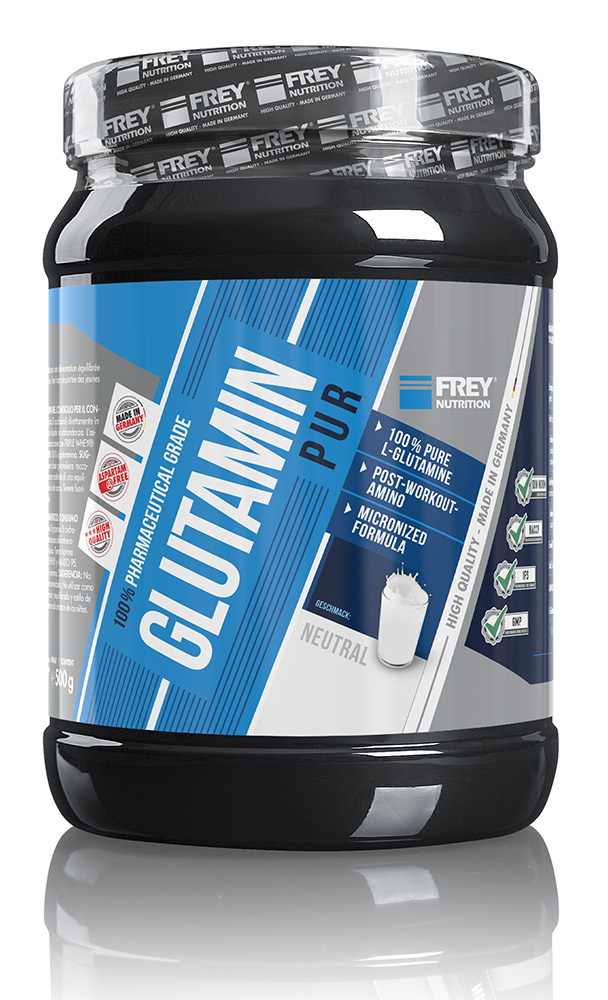WHAT EFFECT DOES GLUTAMINE HAVE ON MUSCLES?
Intense physical exertion (such as hard strength training, but also exhausting endurance training) uses up a lot of muscle glycogen (the storage form of carbohydrates in the muscles). These stores must be replenished after training, otherwise regeneration may be delayed and progress in training may not be made. Intense training can also cause a drop in the glutamine content in the muscles, which can promote possible overtraining.
Previous studies have already shown that the intake of the non-essential amino acid L-GLUTAMINE after training, it can promote the rebuilding of glycogen in the muscles and increase the glutamine level, which is important for the muscle cells. Since then, this amino acid has been considered particularly important for athletes and strength athletes in particular use it regularly after training to ensure that the muscles are adequately supplied with glutamine.
In the present study by Bowtell JL et al. Seven male subjects were exercised on a bicycle ergometer until they were exhausted in order to break down muscle glycogen. The protocol included 30 minutes of exercise on the bicycle ergometer at 70% of maximum oxygen uptake. This was followed by 6 x 1 minute periods with twice the load. The breaks between the intervals were 2 minutes each. This was followed by 45 minutes at 70% of maximum oxygen uptake.
This type of exercise ensured that the glycogen stores in all fibers (i.e. type I and type II fibers) were largely depleted. After this exercise, the subjects were given either a carbohydrate drink (18.5% glucose polymers in 330 ml water), a carbohydrate drink together with 8 g of glutamine (the same drink with an additional 8 g of glutamine), or just 8 g of glutamine (in a placebo drink without carbohydrates). Blood tests were carried out every 15 minutes thereafter for a total of 2 hours.
THE RESULT
BOTH WHEN GLUTAMINE WAS ADMINISTERED ALONE AND WHEN GLUCOSE POLYMERS AND GLUTAMINE WERE ADMINISTERED, THERE WAS AN AVERAGE INCREASE IN GLUTAMINE LEVELS OF 46%.
This result shows that glutamine taken orally is not only absorbed by the intestinal cells, but also appears to a large extent in the blood. The results also show that the administration of glutamine alone was able to significantly increase the glycogen content in the muscles. The simultaneous insulin output was lower than when taken with carbohydrates. The mechanism by which glutamine increased glycogen storage in the skeletal muscles even without carbohydrates has not yet been fully clarified. It is assumed that the swelling of the muscle cell caused by this amino acid (by increasing the cell fluid) led to an activation of the enzyme glycogen synthase. This enzyme is responsible for glycogen storage within the cell. The combined drink of carbohydrates and glutamine led to the HIGHEST INSULIN OUTPUT in this study. Total glycogen storage in the body was highest with this combination.
The results of this study suggest that GLUTAMINE which can support the regeneration processes in the body after exhausting exercise. Glutamine intake is particularly useful in combination with carbohydrates, as studies have shown that this leads to a high insulin output. Insulin is responsible for the rapid drop in catabolic stress hormones (especially cortisol) and supports protein synthesis in trained muscles.
According to this study, glutamine alone without carbohydrates can also SUPPORT REGENERATION . Glycogen storage is boosted to a similar extent as with isolated carbohydrate intake, but without triggering an increased insulin release, as is observed with readily available carbohydrates. Insulin levels should be kept in mind, especially during a diet phase, to ensure constant fat burning. So anyone who is following a reduction diet and values increased fat burning through calorie reduction should keep insulin levels as low as possible. Glutamine meets this criterion, as the amino acid can support muscle regeneration through adequate glycogen storage and replenishment of glutamine stores, according to this study, without insulin levels increasing, as is the case with carbohydrates. This means that fat burning is not impaired.
All in all, glutamine seems to be universally applicable to athletes, both in the build-up phase to support sufficient glutamine uptake in the body and during calorie reduction. 5 to 15 g GLUTAMINE combined with 60 to 100 g CARBOHYDRATES (both doses depend on individual body weight) directly after training are recommended in the build-up phase. In the diet, 2 to 3 individual doses of 3 g glutamine each and one dose after training are useful in order to prevent a glutamine deficiency caused by the calorie reduction in a diet. Quickly available carbohydrates are also important during the diet for replenishing glycogen in the muscles, but then in a significantly reduced amount of around 50% of the normal dosage.











